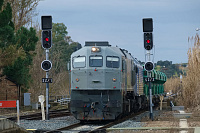When the telephone networks started to go digital in the 1960s, the voice sampling frequency was carried in the physical layer of the multiplexed digital voice signal. This frequency was transported across the network so that all voice switches could operate at the same frequency, as any mismatch would cause clicks and pops in the voice channel.
Packet networks technologies such as Ethernet also have a physical layer signal that carries the timing of the individual bits. However, in Ethernet that’s where it stopped – it was purely a point-to-point bit clock, and was only intended to allow the bits to be accurately transferred from one device to another.
Synchronous Ethernet (SyncE) uses that physical timing signal to carry an accurate frequency as well. That way a chain of SyncE-enabled Ethernet switches can distribute a frequency from one side of a network to the other. This is more accurate than trying to carry frequency at the packet level, because it is immune to packet delay variation. SyncE is commonly used to provide frequency synchronisation in networks, and in particular to provide an accurate reference frequency to mobile basestations.






































































